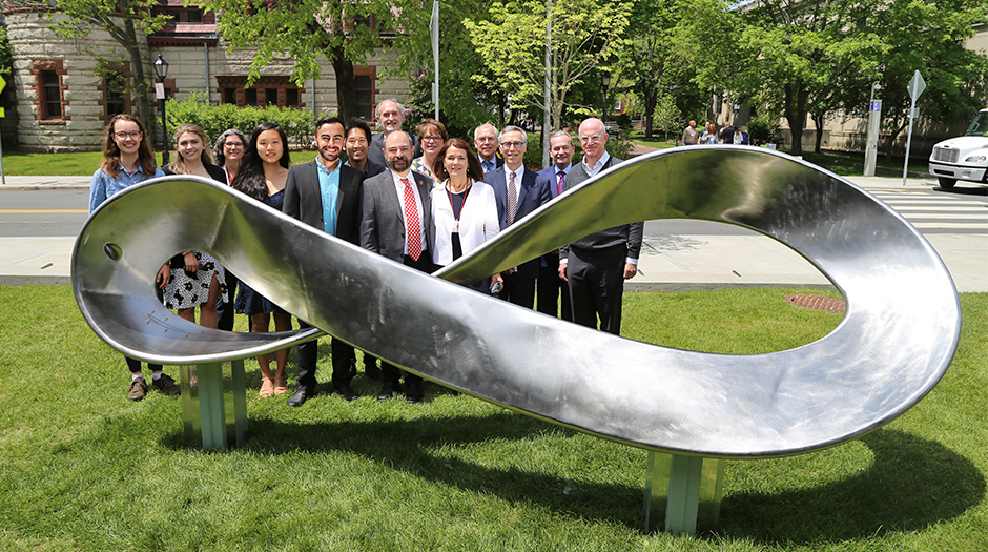 As alumni returned to campus and thousands of new graduates prepared to receive their degrees and begin the next chapter of their lives, the Brown community dedicated a student-designed sundial sculpture named 'Infinite Possibility.'
As alumni returned to campus and thousands of new graduates prepared to receive their degrees and begin the next chapter of their lives, the Brown community dedicated a student-designed sundial sculpture named 'Infinite Possibility.'
At high noon on Saturday, May 25, members of the Brown University community gathered to dedicate the newest public art installation on College Hill — a student-designed sundial sculpture that marks the position of the noonday sun on Giancarlo Plaza in front of Brown's Engineering Research Center.
The stainless-steel structure, called "Infinite Possibility," takes the shape of a Möbius strip — a half-twisted loop with the peculiar characteristic of having only one continuous surface. At noon each day, a spot of sunlight peaks through a small hole on one side of the structure, landing on the inside of the loop. Over the course of a year, the spot of sun traces along an analemma, a figure-eight-shaped diagram of the sun's annual path.
At Saturday's dedication, Brown President Christina Paxson described the piece and its melding of art, science, design and engineering as the embodiment of "so many great things about Brown."
"We know the Möbius strip has engineering and physics and mathematical properties… [and] we're right here in front of this glorious engineering research center so it's sited perfectly," Paxson said. "It also embodies sort of the innovation and collaboration and, I would say, persistent spirit that our students also display."
Paxson thanked the students who oversaw the design, construction and installation of the piece. The work was done by Brown STEAM, an interdisciplinary student group that explores the intersection of art, science and math. The core leaders of the project were Brown juniors David Schurman, Elizabeth Austin and Emma Abele, as well as Class of 2019 graduates Ethan Mok and Linda Park, who were both set to receive their degrees the following day.
Paxson also extended thanks to Charles Giancarlo, a Class of 1979 engineering alumnus who sponsored the project and made a point of involving students in its creation. Two years ago, working with administrators at the School of Engineering, Giancarlo laid out broad guidelines for what he had in mind. Giancarlo wanted something that captured the mix of science and art that characterizes engineering at Brown. He wanted something that people could physically interact with, yet would last for many years. And he wanted something that would the position of the sun — humankind's oldest means of telling time.
"I think what Charlie really knew was that Brown students rise to challenges, and they certainly rose to this one in the most glorious way possible," Paxson said.
Giancarlo applauded the "remarkable and magnificent work" done by the students.
"It speaks to the true Brown promise, I think, and the Brown purpose, which is creating infinite possibilities for our students and in turn creating infinite possibilities for the world through our students," Giancarlo said. "It really reflects the Brown experience in its essence: It's the perfect nexus of art and science, sublimely simple in many ways but with multi-layers of complexity. It explicitly displays its intended purpose while incorporating many additional layers for the curious."
Engineering Dean Larry Larson echoed the sentiment that the piece captures the essence of Brown's spirit and mission.
"With 'Infinite Possibility,' here we have this gorgeous Möbius strip design integrated with a very robust sundial," Larson said. "This is a perfect physical embodiment, I think, of the liberal arts ideal — the integration of all knowledge."
The dedication came amid the celebration of Brown's Commencement and Reunion Weekend 2019, as thousands of new Brown graduates prepared for the next chapter of their lives and the infinite possibilities that await them.